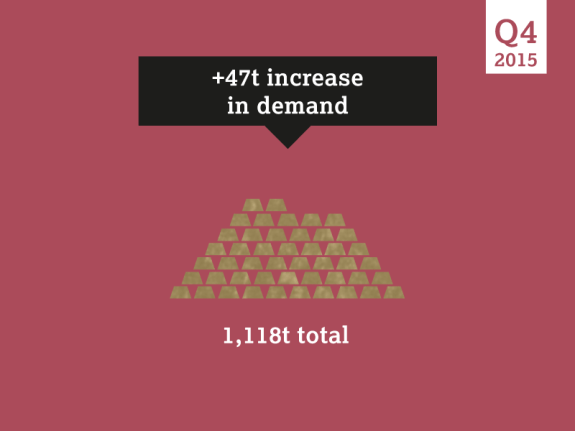After a tepid first half of 2015, demand for gold rallied during the last half of the year, despite a number of economic and external factors working against it.
According to the World Gold Council’s Gold Demand Trends Full Year 2015 a surge in demand during the fourth quarter turned around what was looking to be a bad year for the yellow metal:

Gold demand in the fourth quarter increased 4% year-on-year to a 10-quarter high of 1,117.7 tons. Full year demand was virtually unchanged…Weakness in the first half of the year was cancelled out by strength in the second half. Fourth quarter growth was driven by central banks (+33 tons) and investment (+25 tons).”
According to the WGC report, a number of external factors contributed to the slow start for gold in 2015. Extreme adverse weather patterns buffeted Indian demand for jewelry, and an economic slowdown combined with financial market turbulence hit demand in China. But things rebounded in both Asian nations during the second half of the year.
Demand in China ticked up 3% in the fourth quarter year-on-year. The improvement was primarily driven by demand for investment bars and coins. Retail sales in China were up 11% in December and 11.2% in November. According to the WGC report, the Chinese are buying gold for its historical role as a safe haven:
The weakness of the domestic currency was cited as a main driver of demand for gold bars and coins, with consumers seeking gold’s wealth protection properties.”
India saw an even more robust demand increase in Q4, growing 6% despite significant obstacles:
Total Indian demand for jewelry, bars, and coins expanded by 6% year-on-year (+14 tons) to 233.2 tons in the fourth quarter. Although traditionally one of the strongest quarters for gold demand in India (as the festival and wedding season gets underway) large parts of Southern India had major difficulties to contend with. Chennai was battered by heavy rainfall and flooding, while falling rubber prices and lower investment from the sizable expat population based in the Middle East hit incomes in Kerala. In Telangana, rural incomes weakened after the deficient monsoon curtailed output of rice and cotton.”









Leave A Comment